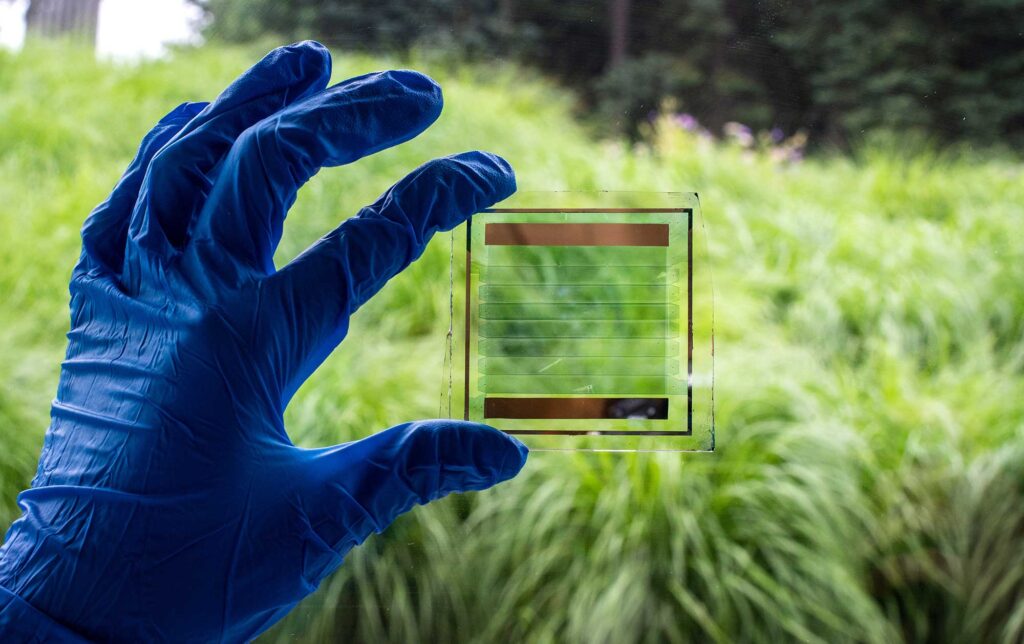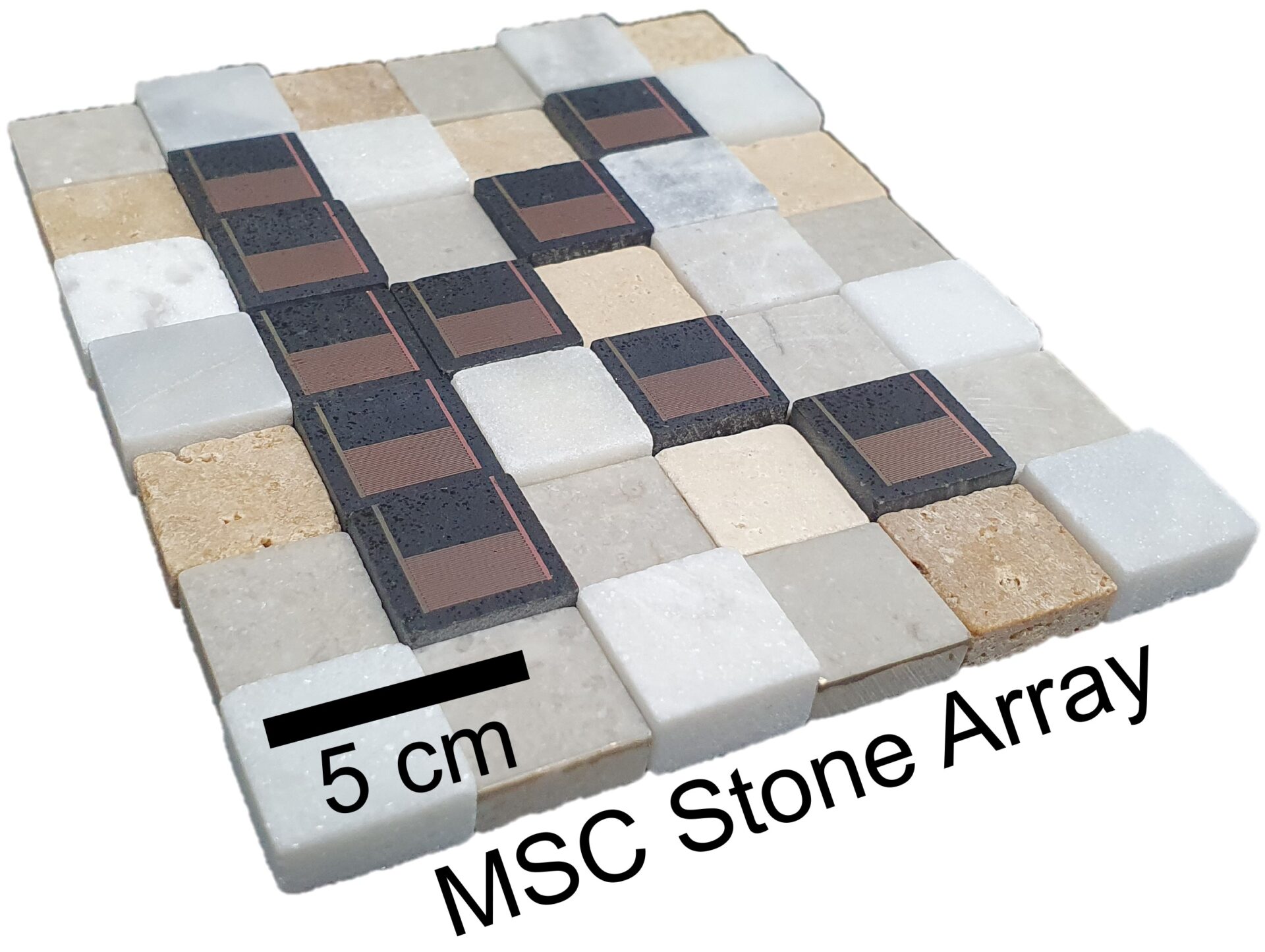
Xinjing Huang, a PhD student in applied physics, demonstrates the semi-transparent view through the solar cell. The new manufacturing process could enable meter-scale electricity-producing windows.
Photo Credit: Silvia Cardarelli, Electrical and Computer Engineering, University of Michigan.
A peel-off patterning technique could enable more fragile organic semiconductors to be manufactured into semitransparent solar panels at scale
In an important step toward bringing transparent solar cells to home windows, researchers at the University of Michigan have developed a way to manufacture their highly efficient and semitransparent solar cells.
“In principle, we can now scale semitransparent organic solar cells to two meters by two meters, which brings our windows much closer to reality,” said Stephen Forrest, the Peter A. Franken Distinguished University Professor of Electrical Engineering and corresponding author of a study published in Joule.
Traditional silicon-based solar cells are completely opaque, which works for solar farms and roofs but would defeat the purpose of windows. However, organic solar cells, in which the light absorber is a kind of plastic, can be transparent.
Organic solar cells have lagged behind their silicon-based cousins for energy-producing purposes due to engineering challenges such as low efficiency and short lifespans, but recent work out of Forrest’s lab has achieved record efficiencies of 10% and estimated lifetimes of up to 30 years.
So the team has turned its attention to making transparent solar cells manufacturable. A significant challenge is creating the micron-scale electrical connections between individual cells that comprise the solar module. Conventional methods that use lasers to pattern the cells can easily damage the organic light absorbers.
Instead, the team developed a multistep peel-off patterning method that achieved micron-scale resolution. They deposited thin films of plastic and patterned them into extremely thin strips. Then, they set down the organic and metal layers. Next, they peeled off the strips, creating very fine electrical interconnections between the cells.
The group connected eight semitransparent solar cells, each 4 cm x 0.4 cm and separated by 200µm-wide interconnections, to create a single 13 cm2 module. The power conversion efficiency of 7.3% was approximately 10% less than for the individual solar cells in the module. This small efficiency loss does not increase with the size of the module; hence, similar efficiencies are expected for meter-scale panels as well. With a transparency nearing 50% and a greenish tint, the cells are suitable for use in commercial windows. Higher transparencies that are likely preferred for the residential market are easily achieved by this same technology.
“It is now time to get industry involved to turn this technology into affordable applications,” said Xinjing Huang, U-M doctoral student in applied physics and first author on the published research.
Eventually, the flexible solar cell panel will be sandwiched between two window panes. The goal for these energy-generating window films is to be about 50% transparent with 10%-15% efficiency. Forrest believes this can be achieved within a couple years.
“The research we are doing is derisking the technology so that manufacturers can make the investments needed to enter large scale production,” Forrest said.
The technique can also be generalized to other organic electronic devices, he says. And in fact, his group is already applying it to OLEDs for white lighting.
The University of Michigan has applied for patent protection and is seeking partners to bring the technology to market.
Original Article: Toward manufacturing semitransparent solar cells the size of windows
More from: University of Michigan
The Latest Updates from Bing News & Google News
Go deeper with Bing News on:
Transparent solar cell windows
- Scientists make breakthrough while investigating potential of solar panels: 'We figured some other ways to capture more solar energy'
Scientists have been hard at work figuring out ways to make solar cells — the part of the solar panel that actually absorbs light — work more efficiently. However, a group of scientists working on ...
- Imperial Academic Secures €2.4m European Funding to Enhance Solar Harvesting Technology
Professor Jenny Nelson has won a prestigious European Research Council grant to learn lessons from plants and apply them to solar technologies.She will use the grant to unpick how plants convert ...
- A shade closer to more efficient organic photovoltaics
Transparent solar cells will transform the look of infrastructure by enabling many more surfaces to become solar panels. Now, materials called non-fullerene acceptors that can intrinsically generate ...
- Ultra-thin, flexible solar cells demonstrate their promise in a commercial quadcopter drone
Whether on Earth or in space, autonomous energy is critical in order to keep power systems running independently for extended periods of time, particularly in remote or unpredictable environments.
- True Green Capital Management and Qcells Partner to Install up to 450MW of Solar Across America
True Green Capital Management LLC ("TGC") is a specialized renewable energy infrastructure private equity firm focused on the U.S. and Europe. TGC is headquartered in Westport, Connecticut in the USA, ...
Go deeper with Google Headlines on:
Transparent solar cell windows
[google_news title=”” keyword=”transparent solar cell windows” num_posts=”5″ blurb_length=”0″ show_thumb=”left”]
Go deeper with Bing News on:
Solar cell windows
- Scientists Have Developed a Solar Cell You Can Bend and Soak in Water
Researchers at the RIKEN Center for Emergent Matter Science and their partners have created a flexible, waterproof organic photovoltaic film. This innovative film enables solar cells to be integrated ...
- Solar Energy News
Apr. 8, 2024 — Researchers have fabricated a new four-terminal organic solar cell with a tandem configuration with a 16.94% power conversion efficiency (PCE). The new device is composed by a ...
- How Do Solar Panels Work?
Credit: Tesla Crystalline silicon is often the material of choice for solar cells because of its durability. The windows on the space shuttles were made of pure fused crystalline silicon.
- Researchers outline path forward for tandem solar cells
As the old saying goes, two heads are better than one. The same is true when it comes to solar cells working in tandem. Researchers at the U.S. Department of Energy's National Renewable Energy ...
- Engineers uncover key to efficient and stable organic solar cells
A team of researchers led by Professor Philip C.Y. Chow from the Department of Mechanical Engineering at the University of Hong Kong (HKU) has made a significant breakthrough in the field of organic ...
Go deeper with Google Headlines on:
Solar cell windows
[google_news title=”” keyword=”solar cell windows” num_posts=”5″ blurb_length=”0″ show_thumb=”left”]










